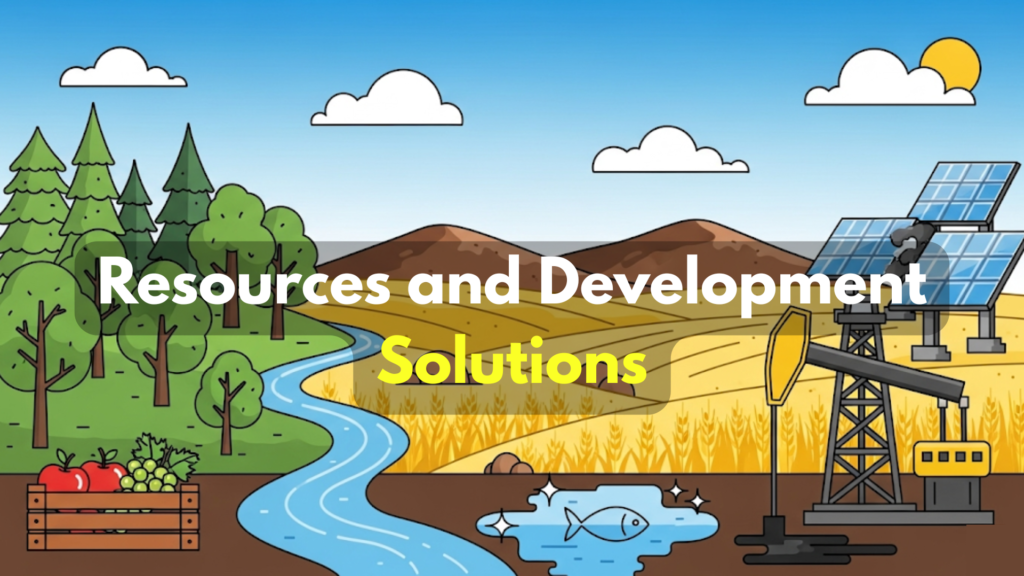Here are the complete Resources and Development Solutions, based primarily on the NCERT textbook for the CBSE Class 10 Geography syllabus, Chapter 1. These solutions cover all important end-of-chapter questions, providing clear, step-by-step answers aligned with the concepts explained in the textbook. Designed to help you understand and apply each topic effectively, the solutions include simplified explanations, accurate terminology, and well-structured responses for MCQs, short, and long answer questions. Whether you are revising for exams or practicing for a deeper understanding, this solution guide is your quick and reliable companion.

EXERCISES
1. Multiple choice questions
(i) Which one of the following is the main cause of land degradation in Punjab?
(a) Intensive cultivation
(b) Deforestation
(c) Over irrigation
(d) Overgrazing
Answer: (c) Over-irrigation
(ii) In which one of the following states is terrace cultivation practiced?
(a) Punjab
(b) Plains of Uttar Pradesh
(c) Haryana
(d) Uttarakhand
Answer: (d) Uttarakhand
(iii) In which of the following states black soil is predominantly found?
(a) Uttar Pradesh
(b) Maharashtra
(c) Rajasthan
(d) Jharkhand
Answer: (b) Maharashtra
2. Answer the following questions in about 30 words
(i) Name three states having black soil and the crop which is mainly grown in it.
Answer: Black soil is predominantly found in Maharashtra, Madhya Pradesh, and Chhattisgarh. The crop mainly grown in this soil is cotton.
(ii) What type of soil is found in the river deltas of the eastern coast? Give three main features of this type of soil.
Answer: Alluvial soil is found in the river deltas of the eastern coast (Mahanadi, Godavari, Krishna, and Kaveri). Its main features are:
- It is very fertile.
- It is rich in potash, phosphoric acid, and lime.
- It is ideal for crops like sugarcane, paddy, and wheat.
(iii) What steps can be taken to control soil erosion in the hilly areas?
Answer: In hilly areas, soil erosion can be controlled by contour ploughing, terrace cultivation, and using strip cropping. These methods slow down the flow of water and restrict the movement of soil.
3. Answer the following questions in about 120 words
(i) Explain land use pattern in India and why has the land under forest not increased much since 1960-61?
Answer: The land use pattern in India is influenced by physical factors like topography, climate, and soil types, as well as human factors such as population density, technology, and culture. The total geographical area is 3.28 million sq km, but data is only available for 93% of the land. Land is used for forests, barren land, non-agricultural purposes, pastures, fallow lands, and the net sown area.
The land under forests has not increased significantly since 1960-61 because of the expansion of agricultural land and human settlements to meet the growing population’s needs. The National Forest Policy of 1952 recommended 33% of the geographical area to be under forests, which is far from being met. This is due to developmental activities, which have led to a decrease in forest cover, and a high demand for land for housing, industry, and infrastructure.
(ii) How have technical and economic development led to more consumption of resources?
Answer: Technical and economic development have increased resource consumption by creating new ways to exploit resources and raising people’s living standards. As technology advances, it becomes easier to extract and process resources that were previously inaccessible or difficult to obtain. This, combined with economic development, increases the demand for consumer goods, energy, and infrastructure, all of which require a large amount of resources. The availability of higher technology enabled colonizing countries to exploit resources in other regions and establish their supremacy. This historical trend continues today, with modern technology and economic growth fueling a cycle of higher consumption and resource depletion.